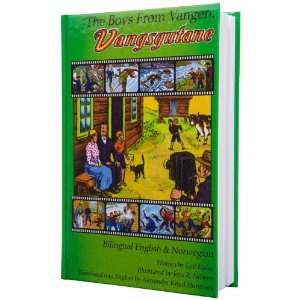|
Rural Yule NorwayRural Yule Norway - Christmas in Norway From the age of 6 to the age of 12 I had the good fortune of experiencing the traditional and comforting celebration of yule – in the local language “jul”, in a rural part of southern Norway.
We lived on a small farm, a few miles up country from the southern town Mandal. It was a beautiful spot, away from the main road and secluded in the best sense of the word. That world was simple, and it allowed a secure and carefree childhood. My brother and I thrived there, skiing in the winter and helping with the chores in the summer. The farm was self-sufficient; it had vegetables, potatoes, and the milk, eggs and butter required for the household. It was wholesome simple food, making the trip to the nearest grocery store infrequent. The school was about 5 kilometers away, we either walked, or, when the snow was deep, we used our skis. There was no such thing as a school bus. Occasionally we might catch a ride on a horse drawn sleigh. The farmers would deliver their milk to a stop on the main road, and then return to their farms near the schoolhouse. In a community where everyone knew everyone it was not a problem to get a ride. The stop on the main road was for a “milk-bus”, a passenger bus that had a section set aside for cylindrical pails of raw milk to be delivered to the dairy in the nearest town. This was a constant in the community, an economic lifeline for the small farms. The schoolhouse would be considered “quaint” today, it was just one large room, and several grades were taught at the same time. I do not think the education suffered. As it was we had an excellent teacher who challenged us to excel. His name was Lodin Aukland, he later became well known as a radio personality in Norway. There was a small library in the school, and I remember that I read every book in it. Every now and then a new set of books would arrive, and I was eager to read them all. At home I had no distraction of television, it had not appeared yet. Reading was the way to learn about the outside world. Snow would come some time in October every year. It is hard to describe the joy it would invoke in us boys when the first heavy snowflakes would swirl outside our windows! It meant we could get out the skis! Walking to school was not nearly as much fun without snow and skis. It may have been tough at times, but we reveled in the challenge of skiing to school, even in a blizzard. In the morning it was mostly uphill, but in the afternoon returning from school, we had downhill skiing on powder snow. No better skiing conditions could be imagined. I remember sunny afternoons swooping down the slopes toward home! In the company of my younger brother, it was pure unadulterated joy! Rural Yule Norway - or Rural Christmas in Norway Once December rolled around there was great anticipation for the Yule season - rural yule Norway. Christmas is an English word; we were unfamiliar with that then. We knew it as “jul”, the Scandinavian word for Yule – or Christmas.
I remember the proceeds were to go to fight tuberculosis. At that time tuberculosis was not quite under control.
Rural Yule Norway The cozy warmth of the Christmas season - Rural Yule Norway - was palpable early in December, there was something called the “Advent” season, the four weeks leading up to Christmas. At school we were rehearsing little plays that we would perform for the audience at the upcoming “Christmas fests”, or as it is known in Norway, “juletrefest”s. These get-togethers were the custom in rural yule Norway. People would come together to walk around the Christmas tree ("juletre") at the schoolhouse and sing the beloved old “julesanger”, or Christmas songs. Then there would be little pauses for entertainment by the school children. It is not within my powers to capture the warmth and the nostalgia of those occasions, but they are a part of my childhood memories. At home we chose a Christmas tree in the forest belonging to the farm, a nice spruce that we would take home to trim with decorations that had been saved from previous years. I remember the glass ornaments, old fashioned, and very beautiful. In the mind of a child they had magic. And the candles were real candles, small white candles, attached to the branches very carefully to balance them so that there would be no fire hazard. No Christmas tree in the world has ever been as meaningful to me as the one in that farmhouse. A wood burning stove provided the heat. Nothing is quite as natural and comforting as the warmth produced by a wood-burning stove. Every small farm in the area had a family with children, in most cases the children were about my own age; it was a time of comfortable community. That same area today has changed; there are fewer working family farms. But the memories of a simpler time live on.
Rural Yule Norway
|
 As children we were recruited to sell “julemerker” (or Christmas seals), door to door. It was for charity, so it was welcomed and accepted as a natural leading up to Christmas.
As children we were recruited to sell “julemerker” (or Christmas seals), door to door. It was for charity, so it was welcomed and accepted as a natural leading up to Christmas. 
